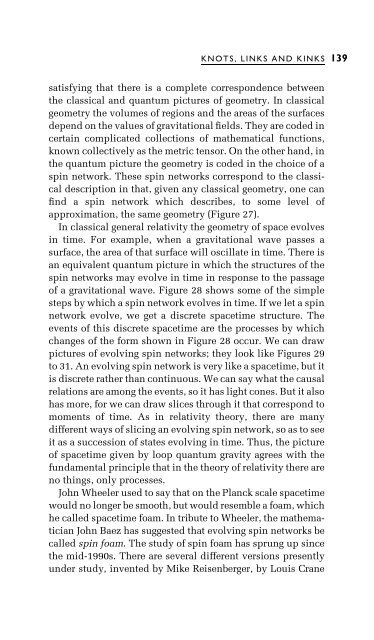Three Roads To Quantum Gravity
Three Roads To Quantum Gravity
Three Roads To Quantum Gravity
You also want an ePaper? Increase the reach of your titles
YUMPU automatically turns print PDFs into web optimized ePapers that Google loves.
KNOTS, LINKS AND KINKS<br />
139<br />
satisfying that there is a complete correspondence between<br />
the classical and quantum pictures of geometry. In classical<br />
geometry the volumes of regions and the areas of the surfaces<br />
depend on the values of gravitational ®elds. They are coded in<br />
certain complicated collections of mathematical functions,<br />
known collectively as the metric tensor. On the other hand, in<br />
the quantum picture the geometry is coded in the choice of a<br />
spin network. These spin networks correspond to the classical<br />
description in that, given any classical geometry, one can<br />
®nd a spin network which describes, to some level of<br />
approximation, the same geometry (Figure 27).<br />
In classical general relativity the geometry of space evolves<br />
in time. For example, when a gravitational wave passes a<br />
surface, the area of that surface will oscillate in time. There is<br />
an equivalent quantum picture in which the structures of the<br />
spin networks may evolve in time in response to the passage<br />
of a gravitational wave. Figure 28 shows some of the simple<br />
steps by which a spin network evolves in time. If we let a spin<br />
network evolve, we get a discrete spacetime structure. The<br />
events of this discrete spacetime are the processes by which<br />
changes of the form shown in Figure 28 occur. We can draw<br />
pictures of evolving spin networks; they look like Figures 29<br />
to 31. An evolving spin network is very like a spacetime, but it<br />
is discrete rather than continuous. We can say what the causal<br />
relations are among the events, so it has light cones. But it also<br />
has more, for we can draw slices through it that correspond to<br />
moments of time. As in relativity theory, there are many<br />
different ways of slicing an evolving spin network, so as to see<br />
it as a succession of states evolving in time. Thus, the picture<br />
of spacetime given by loop quantum gravity agrees with the<br />
fundamental principle that in the theory of relativity there are<br />
no things, only processes.<br />
John Wheeler used to say that on the Planck scale spacetime<br />
would no longer be smooth, but would resemble a foam, which<br />
he called spacetime foam. In tribute to Wheeler, the mathematician<br />
John Baez has suggested that evolving spin networks be<br />
called spin foam. The study of spin foam has sprung up since<br />
the mid-1990s. There are several different versions presently<br />
under study, invented by Mike Reisenberger, by Louis Crane



![arXiv:1001.0993v1 [hep-ph] 6 Jan 2010](https://img.yumpu.com/51282177/1/190x245/arxiv10010993v1-hep-ph-6-jan-2010.jpg?quality=85)


![arXiv:1008.3907v2 [astro-ph.CO] 1 Nov 2011](https://img.yumpu.com/48909562/1/190x245/arxiv10083907v2-astro-phco-1-nov-2011.jpg?quality=85)








![arXiv:1002.4928v1 [gr-qc] 26 Feb 2010](https://img.yumpu.com/41209516/1/190x245/arxiv10024928v1-gr-qc-26-feb-2010.jpg?quality=85)
![arXiv:1206.2653v1 [astro-ph.CO] 12 Jun 2012](https://img.yumpu.com/39510078/1/190x245/arxiv12062653v1-astro-phco-12-jun-2012.jpg?quality=85)
